
Vanda, abbreviated in the horticultural trade as V., is a genus in the orchid family, Orchidaceae. There are about 87 species, and the genus is commonly cultivated for the marketplace. This genus and its allies are considered to be among the most specifically adapted of all orchids within the Orchidaceae. The genus is highly prized in horticulture for its showy, fragrant, long-lasting, and intensely colorful flowers. Vanda species are widespread across East Asia, Southeast Asia, and New Guinea, with a few species extending into Queensland and some of the islands of the western Pacific.
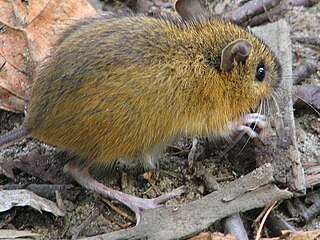
The woodland jumping mouse is a species of jumping mouse found in North America. It can jump up to 3 m (9.8 ft) using its extremely strong feet and long tail.
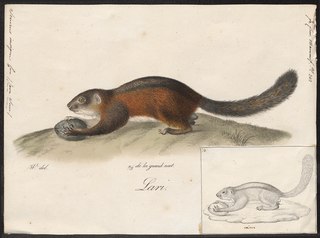
Striped ground squirrels form a taxon of squirrels under the subfamily Callosciurinae. They are only found in Southeast Asia. Species in this genus include:

The fiery-throated hummingbird is a species of hummingbird in the "mountain gems" tribe Lampornithini in subfamily Trochilinae. It is found in Costa Rica and Panama.
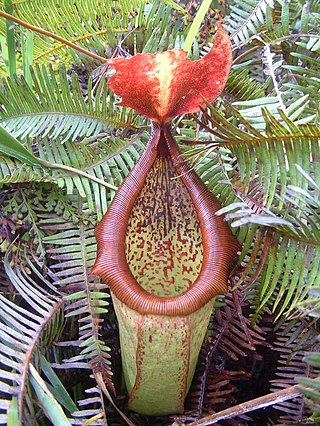
Nepenthes insignis is a tropical pitcher plant endemic to New Guinea and surrounding islands. The specific epithet insignis is Latin for "distinguished" or "remarkable".
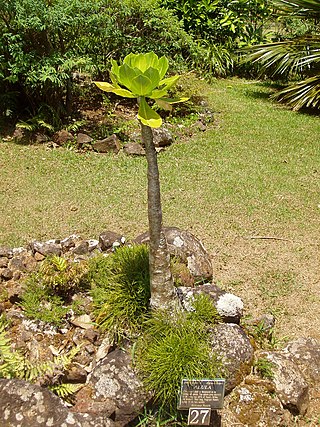
Brighamia insignis, commonly known as ʻŌlulu or Alula in Hawaiian, or colloquially as the vulcan palm or cabbage on a stick, is an endangered species of Hawaiian lobelioid in the bellflower family, Campanulaceae. It is native to the islands of Kauaʻi and Niʻihau. This short-lived perennial species is a member of a unique endemic Hawaiian genus with only one other species.

The white-bellied heron also known as the imperial heron or great white-bellied heron, is a large heron species living in the foothills of the eastern Himalayas in northeast India and Bhutan to northern Myanmar. It inhabits undisturbed rivers and wetlands. It has been listed as Critically Endangered on the IUCN Red List since 2007, because the global population is estimated at less than 300 mature individuals and threatened by habitat loss and human disturbance. It is mostly dark grey with a white throat and underparts.

The white-throated bush chat, also known as Hodgson's bushchat, is an Old World flycatcher in the genus Saxicola. It is IUCN Red Listed as Vulnerable by BirdLife International. In 2001, the global population has been estimated at between 3,500 and 15,000 individuals. The major threat appears to be the rapid loss of grasslands in its wintering areas. It winters in the Nepal and Indian Terai and in the Dooars. In this region, it has been recorded in Jim Corbett, Shuklaphanta, Chitwan, Kaziranga, and Manas National Parks and in Lumbini Crane Sanctuary. It prefers wet and dry grasslands, reeds and tamarisks along riverbeds, and also occurs in sugarcane fields. In spring and summer, it breeds in the alpine or sub-alpine meadows and scrub in the mountains of Mongolia and adjacent parts of Russia.

The European free-tailed bat is a species of free-tailed bat found in the Old World. Other common names include the bulldog bat and the mastiff bat because of the presence of wrinkling on the snout. This bat is found in the Mediterranean region of Europe and in scattered locations across Asia at altitudes from sea level to 3100 m. The range of distribution is from the Canary Islands and Madeira through the whole Mediterranean area, Asia Minor, the Caucasus and the Middle East. In the north to southern France, southern Germany, Switzerland, Croatia and Bulgaria. It was reported from Korea in 1931, but has not been sighted on the Korean Peninsula since then. Populations in Japan, Taiwan and Korea are now considered to be a separate species Tadarida insignis.

The white-rumped falcon is a species of bird of prey in the family Falconidae native to Indochina. It is placed in its own monotypic genus, Neohierax.

The brown-capped weaver is a species of bird in the family Ploceidae. It is found in Angola, Burundi, Cameroon, Republic of the Congo, Democratic Republic of the Congo, Equatorial Guinea, Kenya, Nigeria, Rwanda, South Sudan, Tanzania, and Uganda.

The white-browed jungle flycatcher, also known as the Luzon jungle-flycatcher and the Rusty-flanked jungle-flycatcher, is a species of bird in the Old World flycatcher family Muscicapidae. It is endemic to Luzon island, in the Philippines. The natural habitat of the white-browed jungle flycatcher is tropical moist montane forests. It is threatened by habitat loss.

Cassin's honeybird, also known as Cassin's honeyguide, is a species of bird in the family Indicatoridae.

The three-striped ground squirrel is a species of rodent in the family Sciuridae. It is found in Indonesia, Malaysia, and Thailand.

The Cameroon scaly-tail, also referred to as the Cameroon anomalure, flightless anomalure or flightless scaly-tail, is a rodent species endemic to West Central Africa. The scientific literature has never reported observations of live individuals. The taxonomic classification of the species has been subject to recent revision.
Brycon insignis, the Tiete tetra, is a species of fish in the family Characidae. It is endemic to the Paraíba do Sul River basin in southeast Brazil. B. insignis migrates upstream to spawn and has traditionally been important to fisheries, but it is now a threatened species.

Vanda tessellata is a species of orchid occurring from the Indian subcontinent to Indochina. It is a medicinal plant.
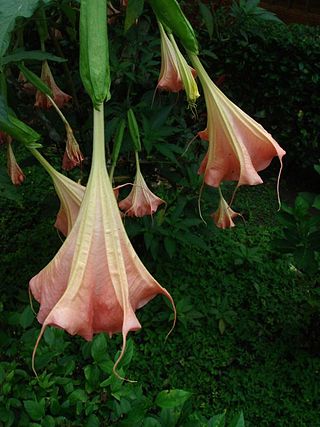
Brugmansia insignis is a South American species of angel's trumpet with large, fragrant flowers. The IUCN has listed this species as Extinct in the Wild, although like the other members of its genus its survival has been ensured by its popularity as an ornamental plant.

Agrionoptera insignis is a species of dragonfly in the family Libellulidae. It is native to much of eastern Asia and Oceania, occurring as far north as Japan and as far south as Australia. It is common in most of its range. The circumscription of the species is not entirely clear, so if the species is redescribed, its status may change. Common names include grenadier.

The JapaneseRed List is the Japanese domestic counterpart to the IUCN Red List of Threatened Species. The national Red List is compiled and maintained by the Ministry of the Environment, alongside a separate Red List for marine organisms. Similarly drawing on the relevant scientific authorities, NGOs, and local governments, the Ministry of the Environment also prepares and publishes a Red Data Book that provides further information on species and habitats.



















